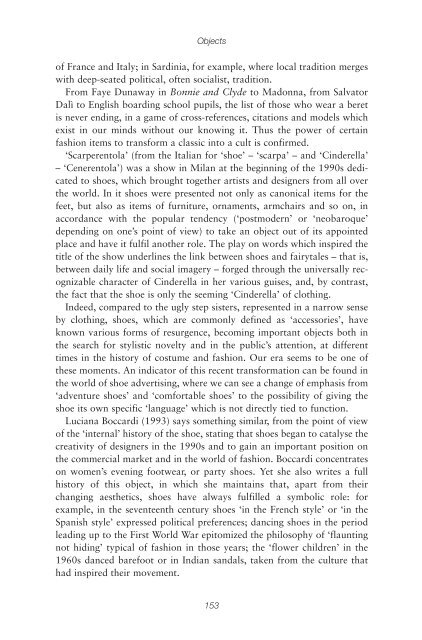Create successful ePaper yourself
Turn your PDF publications into a flip-book with our unique Google optimized e-Paper software.
Objects<br />
of France and Italy; in Sardinia, for example, where local tradition merges<br />
with deep-seated political, often socialist, tradition.<br />
From Faye Dunaway in Bonnie and Clyde to Madonna, from Salvator<br />
Dalì to English boarding school pupils, the list of those who wear a beret<br />
is never ending, in a game of cross-references, citations and models which<br />
exist in our minds without our knowing it. Thus the power of certain<br />
fashion items to transform a classic into a cult is confirmed.<br />
‘Scarperentola’ (from the Italian for ‘shoe’ – ‘scarpa’ – and ‘Cinderella’<br />
– ‘Cenerentola’) was a show in Milan at the beginning of the 1990s dedicated<br />
to shoes, which brought together artists and designers from all over<br />
the world. In it shoes were presented not only as canonical items for the<br />
feet, but also as items of furniture, ornaments, armchairs and so on, in<br />
accordance with the popular tendency (‘postmodern’ or ‘neobaroque’<br />
depending on one’s point of view) to take an object out of its appointed<br />
place and have it fulfil another role. <strong>The</strong> play on words which inspired the<br />
title of the show underlines the link between shoes and fairytales – that is,<br />
between daily life and social imagery – forged through the universally recognizable<br />
character of Cinderella in her various guises, and, by contrast,<br />
the fact that the shoe is only the seeming ‘Cinderella’ of clothing.<br />
Indeed, compared to the ugly step sisters, represented in a narrow sense<br />
by clothing, shoes, which are commonly defined as ‘accessories’, have<br />
known various forms of resurgence, becoming important objects both in<br />
the search for stylistic novelty and in the public’s attention, at different<br />
times in the history of costume and fashion. Our era seems to be one of<br />
these moments. An indicator of this recent transformation can be found in<br />
the world of shoe advertising, where we can see a change of emphasis from<br />
‘adventure shoes’ and ‘comfortable shoes’ to the possibility of giving the<br />
shoe its own specific ‘language’ which is not directly tied to function.<br />
Luciana Boccardi (1993) says something similar, from the point of view<br />
of the ‘internal’ history of the shoe, stating that shoes began to catalyse the<br />
creativity of designers in the 1990s and to gain an important position on<br />
the commercial market and in the world of fashion. Boccardi concentrates<br />
on women’s evening footwear, or party shoes. Yet she also writes a full<br />
history of this object, in which she maintains that, apart from their<br />
changing aesthetics, shoes have always fulfilled a symbolic role: for<br />
example, in the seventeenth century shoes ‘in the French style’ or ‘in the<br />
Spanish style’ expressed political preferences; dancing shoes in the period<br />
leading up to the First World War epitomized the philosophy of ‘flaunting<br />
not hiding’ typical of fashion in those years; the ‘flower children’ in the<br />
1960s danced barefoot or in Indian sandals, taken from the culture that<br />
had inspired their movement.<br />
153

















